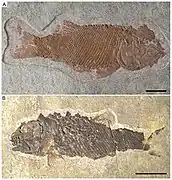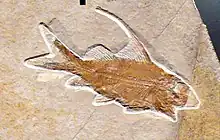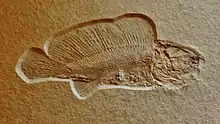Ginglymodi
Ginglymodi is a clade of ray-finned fish containing modern-day gars (Lepisosteidae) and their extinct relatives, including the family Lepidotidae and the orders Semionotiformes and Kyphosichthyiformes, and various other extinct taxa. Ginglymodi is one of the two major subgroups of the infraclass Holostei, the other one being Halecomorphi, which contains the bowfin and its fossil relatives.[2][7]

| Neopterygii |
| ||||||||||||
| Ginglymodi Temporal range: | |
|---|---|
.jpg.webp) | |
| Spotted gar (Lepisosteus oculatus) | |
 | |
| Macrosemimimus fegerti (Semionotiformes) from the Upper Jurassic of Germany | |
| Scientific classification | |
| Domain: | Eukaryota |
| Kingdom: | Animalia |
| Phylum: | Chordata |
| Class: | Actinopterygii |
| Infraclass: | Holostei |
| Clade: | Ginglymodi Cope, 1871 |
| Subgroups | |
| |
Fossil record
The fossil record of ginglymodians goes back at least to the Anisian stage of the Triassic period, over 240 million years ago.[8] Eosemionotus is one of the earliest ginglymodians. Acentrophorus, another taxon from the Wuchiapingian stage of the late Permian, and Paracentrophorus from the Early Triassic epoch, could be even earlier members of the group. Ginglymodi was diverse and widespread during the Mesozoic era, but they represent a depauperate lineage today. The group first evolved in marine environments, but several lineages made separate transitions into freshwater environments.[9] Ginglymodi underwent substantial diversification during the Late Triassic and the Late Jurassic.[10] The earliest known gars are from the Late Jurassic.[11] Ginglymodians underwent a major decline during the mid-Cretaceous, eventually leaving gars as the only surviving members of the group.[10] Gar fossils have been found on all continents except Australia and Antarctica. Only seven species exist today, distributed in the freshwater systems of North America.[11]
 The Middle Triassic Ticinolepis
The Middle Triassic Ticinolepis





References
- Xu, G.; Ma, X.; Wu, F.; Ren, Y. (2019). "A Middle Triassic kyphosichthyiform from Yunnan, China, and phylogenetic reassessment of early ginglymodians". Vertebrata PalAsiatica. 57 (3): 181–204. doi:10.19615/j.cnki.1000-3118.190319.
- López-Arbarello, A.; Sferco, E. (2018). "Neopterygian phylogeny: the merger assay". Royal Society Open Science. 5 (3): 172337. Bibcode:2018RSOS....572337L. doi:10.1098/rsos.172337. PMC 5882744. PMID 29657820.
- de Paiva, H. C. L.; Gallo, V. (2018). "Quasimodichthys gen. nov. (Neopterygii: Semionotiformes): A morphological and ontogenetic study". Journal of South American Earth Sciences. 88: 132–143. Bibcode:2018JSAES..88..132P. doi:10.1016/j.jsames.2018.08.010. S2CID 134986658.
- Murray, A. M.; Xing, L.; Divay, J.; Liu, J.; Wang, F. (2015). "A Late Jurassic freshwater fish (Ginglymodi, Lepisosteiformes) from Qijiang, Chongqing, China". Journal of Vertebrate Paleontology. 35 (2): e911187. Bibcode:2015JVPal..35E1187M. doi:10.1080/02724634.2014.911187. S2CID 85946657.
- Deesri, U.; Jintasakul, P.; Cavin, L. (2016). "A new Ginglymodi (Actinopterygii, Holostei) from the Late Jurassic–Early Cretaceous of Thailand, with comments on the early diversification of Lepisosteiformes in Southeast Asia". Journal of Vertebrate Paleontology. 36 (6): e1225747. Bibcode:2016JVPal..36E5747D. doi:10.1080/02724634.2016.1225747. S2CID 89359438.
- López-Arbarello, A. (2012). "Phylogenetic Interrelationships of Ginglymodian Fishes (Actinopterygii: Neopterygii)". PLOS ONE. 7 (7): e39370. Bibcode:2012PLoSO...739370L. doi:10.1371/journal.pone.0039370. PMC 3394768. PMID 22808031.
- Nelson, Joseph, S. (2016). Fishes of the World. John Wiley & Sons, Inc. ISBN 978-1-118-34233-6.
{{cite book}}: CS1 maint: multiple names: authors list (link) - Romano, Carlo (2021). "A Hiatus Obscures the Early Evolution of Modern Lineages of Bony Fishes". Frontiers in Earth Science. 8: 672. doi:10.3389/feart.2020.618853. ISSN 2296-6463.
- Cavin, Lionel; Deesri, Uthumporn; Olive, Sébastien (2019-07-22). "Scheenstia bernissartensis (Actinopterygii: Ginglymodi) from the Early Cretaceous of Bernissart, Belgium, with an appraisal of ginglymodian evolutionary history". Journal of Systematic Palaeontology. 18 (6): 513–527. doi:10.1080/14772019.2019.1634649. ISSN 1477-2019. S2CID 199631685.
- Cawley, John J.; Marramà, Giuseppe; Carnevale, Giorgio; Villafaña, Jaime A.; López‐Romero, Faviel A.; Kriwet, Jürgen (February 2021). "Rise and fall of †Pycnodontiformes: Diversity, competition and extinction of a successful fish clade". Ecology and Evolution. 11 (4): 1769–1796. doi:10.1002/ece3.7168. ISSN 2045-7758. PMC 7882952. PMID 33614003.
- Paulo M. Brito; Jésus Alvarado-Ortega; François J. Meunier (2017). "Earliest known lepisosteoid extends the range of anatomically modern gars to the Late Jurassic". Scientific Reports. 7 (1): Article number 17830. Bibcode:2017NatSR...717830B. doi:10.1038/s41598-017-17984-w. PMC 5736718. PMID 29259200.
.jpg.webp)
.jpg.webp)